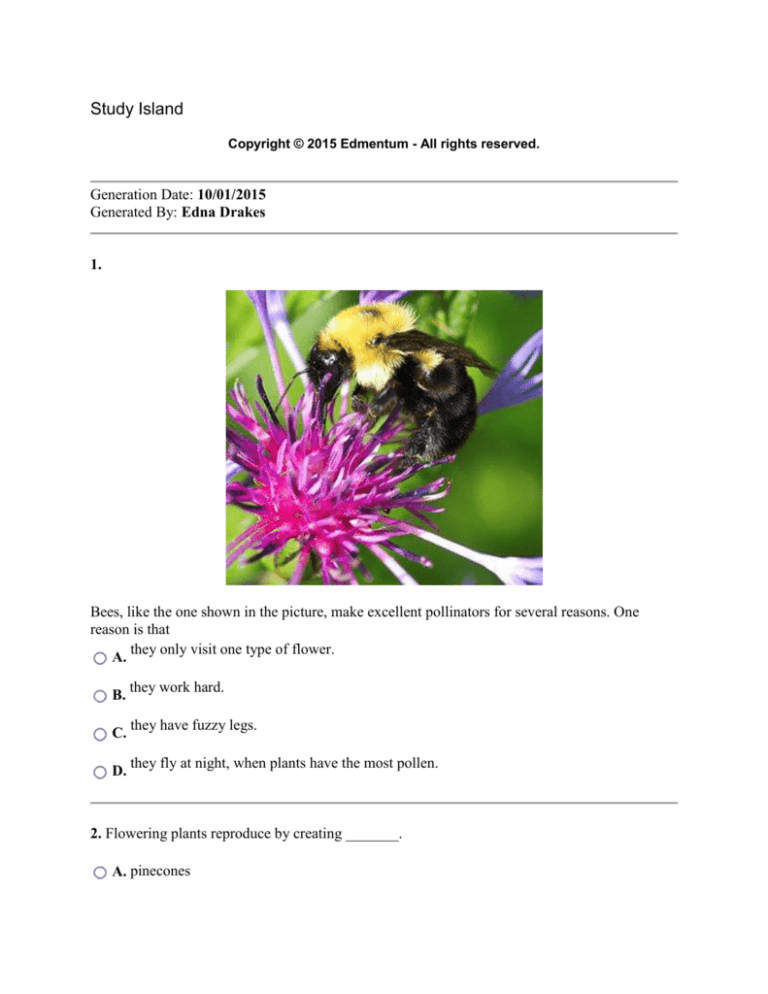
Study Island
Copyright © 2015 Edmentum - All rights reserved.
Generation Date: 10/01/2015
Generated By: Edna Drakes
1.
Bees, like the one shown in the picture, make excellent pollinators for several reasons. One
reason is that
they only visit one type of flower.
A.
B.
C.
D.
they work hard.
they have fuzzy legs.
they fly at night, when plants have the most pollen.
2. Flowering plants reproduce by creating _______.
A. pinecones
B. thorns
C. seeds
D. spores
3.
The flower part labeled 4 in the picture is the female reproductive organ. What is the name of
this part?
A. ovary
B. seed
C. ovule
D. pistil
4.
What is the number that points to the ovary?
A. 4
B. 3
C. 1
D. 5
5. Some plant seeds have special spiky barbs that can easily get tangled in an animal's fur.
The spiky structure of these seeds most likely benefits a plant by
attracting pollinators with their bright color and fruity smell.
A.
B.
C.
D.
keeping animals far away from the parent plant.
helping the seeds to be scattered in new areas to grow.
keeping the seeds from being moved away from the parent plant.
6. Pollination occurs when pollen is transferred
A. from the anthers to the stigma.
B. from the ovary to filament.
C. from the stigma to the anthers.
D. from the ovules to the stamens.
7. Female (egg) cells in flowering plants are found in structures called _______.
A. ovules
B. petals
C. stamens
D. sepals
8.
Which flower part contains the ovules?
A. ovary
B. stem
C. stamen
D. sepal
9. Which of the following is made by male plant cells and is important for the reproduction of
flowering plants?
A. stigma
B. photosynthesis
C. ovule
D. pollen
10. Blackberry plants have small hard seeds that are covered by a thick, fleshy fruit.
Many kinds of animals eat blackberries. Which of the following will most likely happen to the
seeds of a blackberry plant after the fruit is eaten by an animal?
The seeds will begin to grow inside the intestine of the animal.
A.
The seeds will be ruined by the animal and will no longer be able to grow into a new
B. blackberry plant.
C.
The seeds will change shape and become a new species of plant.
The seeds will be deposited in the animal's waste so that they can grow into a new
D. blackberry plant.
Answers
1. C
2. C
3. D
4. C
5. C
6. A
7. A
8. A
9. D
10. D
Explanations
1. Bees have fuzz on their legs, and many bees have fuzz on their bodies. Pollen clings easily to
this fuzz, and as the bee moves around, the pollen is brushed against the stigma of the flower,
helping pollinate the plant.
2. Flowering plants reproduce using seeds. Other plants use other means of reproduction.
3. Flower part 4 is the pistil. The pistil is the female reproductive organ. It is made of three parts:
the stigma, which is the sticky or feathery part,
the style, which connects the stigma to the ovary, and
the ovary, which contains the egg cells (ovules).
4. Number 1 points to the ovary.
When the fertilized eggs become seeds, the ovary grows into a fruit. The fruit protects the seeds.
It also helps spread the seeds by tasting good to animals.
Animals eat the fruit and carry the seeds in their stomachs. When the seeds leave the animals'
bodies, the seeds have been carried far from the parent plant.
5. Some plants have spiky, burr-like seeds that stick to the fur of any animal walking by. After a
while, the seeds will fall off of the fur and into the dirt in some other location. A new plant can
grow from this seed.
Therefore, the spiky structure of some seeds most likely benefits a plant by helping the seeds to
be scattered in new areas to grow.
6. Pollen is produced on the anther. Once pollen lands on the stigma, it makes its way to the
ovary, where it fertilizes the ovule, or egg.
7. Ovules contain the egg cells produced in the ovary of a plant. The ovary is found at the base
of the pistil and is a female part of the plant.
8. The ovary contains the ovules.
When the fertilized eggs become seeds, the ovary grows into a fruit. The fruit protects the seeds.
It also helps spread the seeds by tasting good so that animals eat the seeds and move them far
away.
9. Pollen is made by the male part of a plant. When pollen joins with ovules made by the female
part of the plant, fertilization happens.
10. Animals often eat the fruit that plants produce. As they eat the fruit, the animals usually eat
the seeds inside as well. The thick, fleshy fruit protects the hard seeds as they pass through the
digestive tract of the animal. When the animal passes the seeds out of its body as waste, a new
plant can grow in the new spot where they are deposited.
Therefore, if an animal eats the fruit of a blackberry, the seeds will usually be deposited in the
animal's waste so that they can grow into a new blackberry plant.





